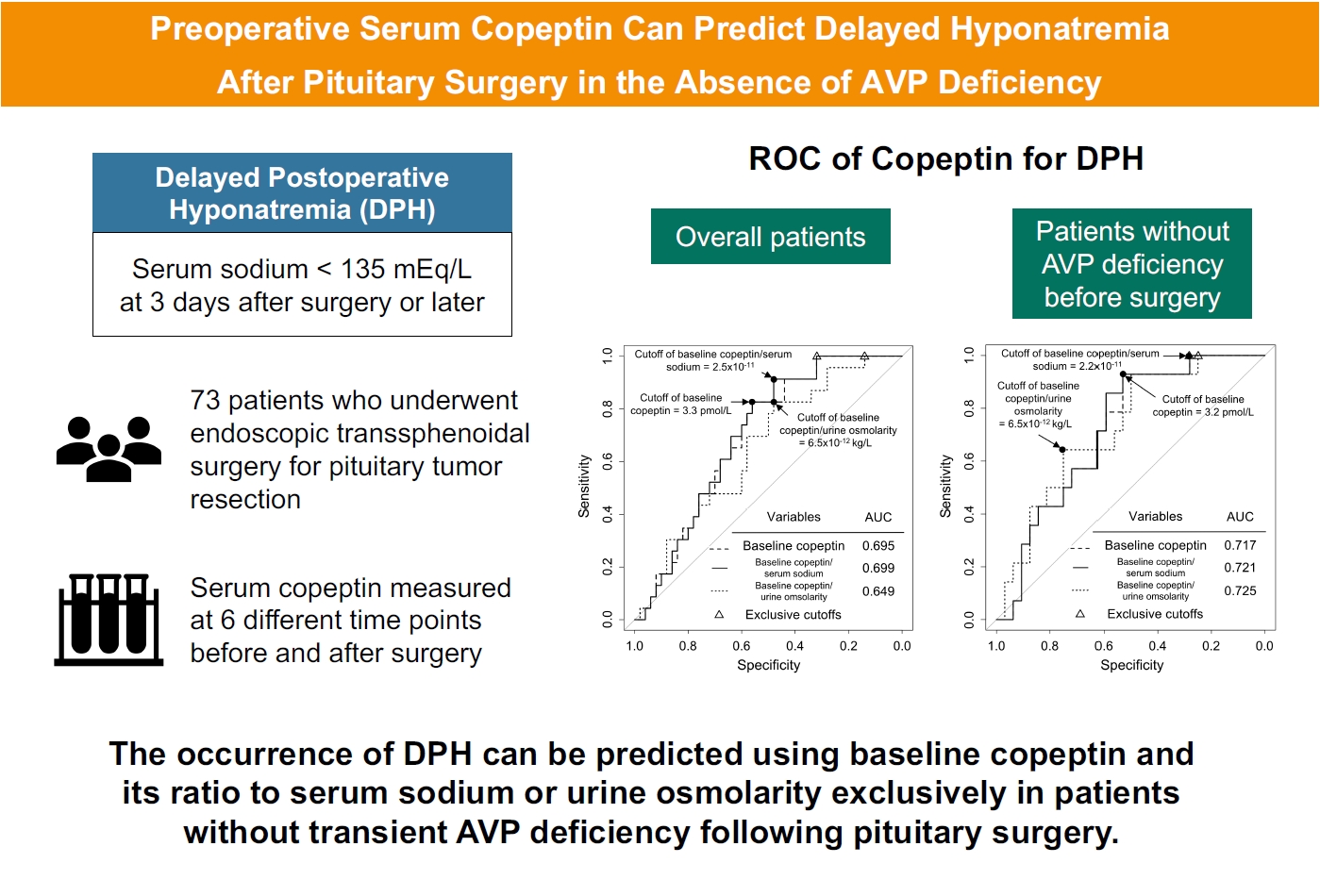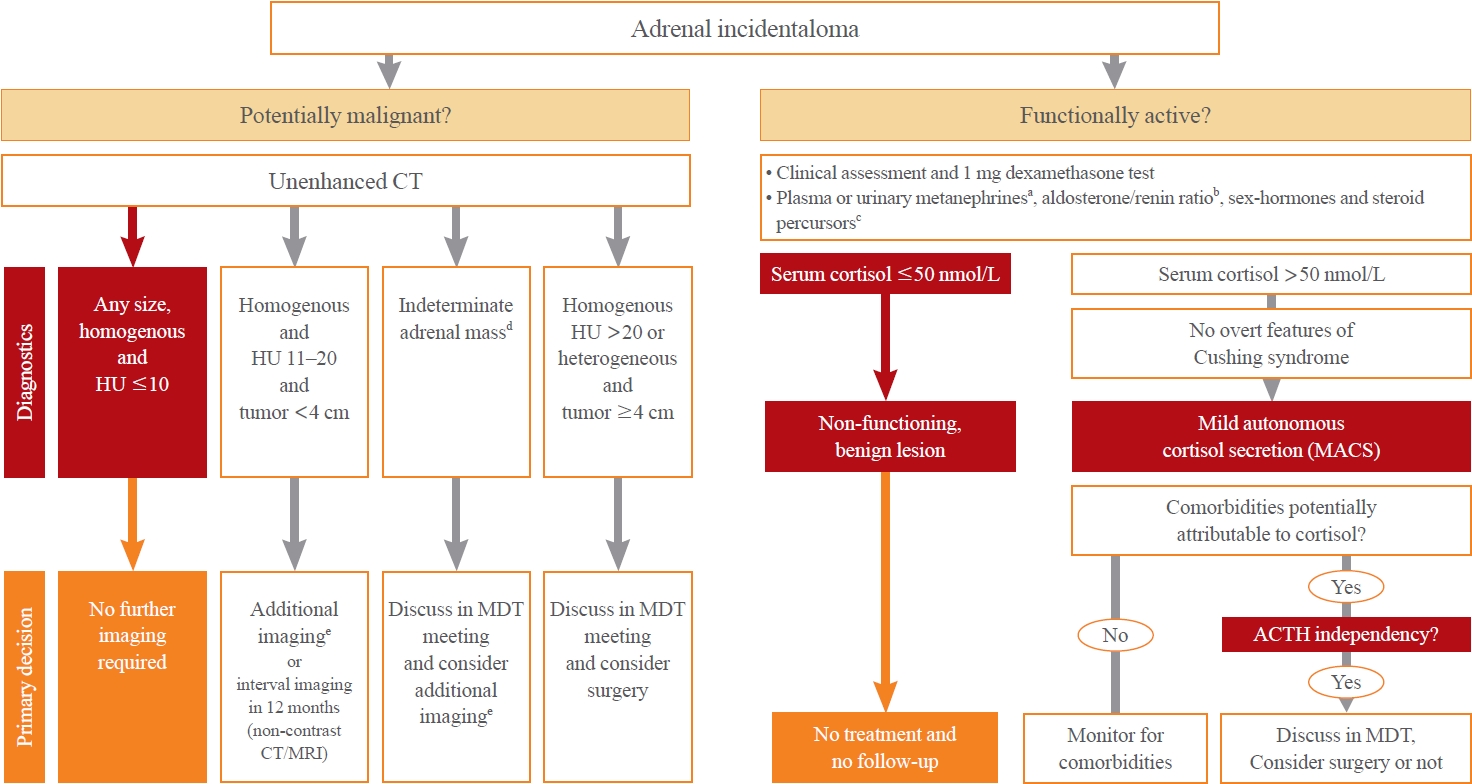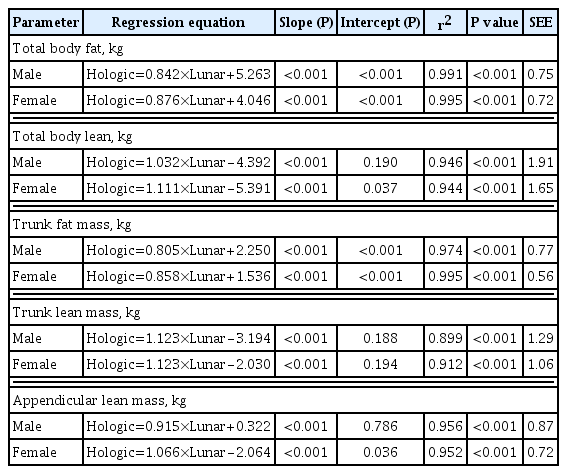Search
- Page Path
- HOME > Search
Original Article
- Hypothalamus and pituitary gland
- Preoperative Serum Copeptin Can Predict Delayed Hyponatremia after Pituitary Surgery in the Absence of Arginine Vasopressin Deficiency
- Ho Kang, Seung Shin Park, Yoo Hyung Kim, Hwan Sub Lim, Mi-Kyeong Lee, Kyoung-Ryul Lee, Jung Hee Kim, Yong Hwy Kim
- Endocrinol Metab. 2024;39(1):164-175. Published online January 3, 2024
- DOI: https://doi.org/10.3803/EnM.2023.1792

- 1,074 View
- 49 Download
-
 Abstract
Abstract
 PDF
PDF Supplementary Material
Supplementary Material PubReader
PubReader  ePub
ePub - Background
Delayed postoperative hyponatremia (DPH) is the most common cause of readmission after pituitary surgery. In this study, we aimed to evaluate the cutoff values of serum copeptin and determine the optimal timing for copeptin measurement for the prediction of the occurrence of DPH in patients who undergo endoscopic transsphenoidal approach (eTSA) surgery and tumor resection.
Methods
This was a prospective observational study of 73 patients who underwent eTSA surgery for pituitary or stalk lesions. Copeptin levels were measured before surgery, 1 hour after extubation, and on postoperative days 1, 2, 7, and 90.
Results
Among 73 patients, 23 patients (31.5%) developed DPH. The baseline ratio of copeptin to serum sodium level showed the highest predictive performance (area under the curve [AUROC], 0.699), and its optimal cutoff to maximize Youden’s index was 2.5×10–11, with a sensitivity of 91.3% and negative predictive value of 92.0%. No significant predictors were identified for patients with transient arginine vasopressin (AVP) deficiency. However, for patients without transient AVP deficiency, the copeptin-to-urine osmolarity ratio at baseline demonstrated the highest predictive performance (AUROC, 0.725). An optimal cutoff of 6.5×10–12 maximized Youden’s index, with a sensitivity of 92.9% and a negative predictive value of 94.1%.
Conclusion
The occurrence of DPH can be predicted using baseline copeptin and its ratio with serum sodium or urine osmolarity only in patients without transient AVP deficiency after pituitary surgery.

Review Article
- Adrenal Gland
- Recent Updates on the Management of Adrenal Incidentalomas
- Seung Shin Park, Jung Hee Kim
- Endocrinol Metab. 2023;38(4):373-380. Published online August 16, 2023
- DOI: https://doi.org/10.3803/EnM.2023.1779

- 7,442 View
- 1,479 Download
-
 Abstract
Abstract
 PDF
PDF PubReader
PubReader  ePub
ePub - Adrenal incidentalomas represent an increasingly common clinical conundrum with significant implications for patients. The revised 2023 European Society of Endocrinology (ESE) guideline incorporates cutting-edge evidence for managing adrenal incidentalomas. This paper provides a concise review of the updated contents of the revised guideline. In the 2023 guideline, in patients without signs and symptoms of overt Cushing’s syndrome, a post-dexamethasone cortisol level above 50 nmol/L (>1.8 μg/dL) should be considered as mild autonomous cortisol secretion. Regarding the criteria of benign adrenal adenomas, a homogeneous adrenal mass with ≤10 Hounsfield units on non-contrast computed tomography requires no further follow-up, irrespective of its size. The updated guideline also discusses steroid metabolomics using tandem mass spectrometry to discriminate malignancy. It underscores the importance of high-volume surgeons performing adrenalectomy and emphasizes the pivotal role of a multidisciplinary team approach in deciding the treatment plan for indeterminate adrenal masses. The guideline advocates for more proactive surgical treatment for indeterminate adrenal masses in young patients (<40 years) and pregnant women. This review of the 2023 ESE guideline underscores the ongoing evolution of the adrenal incidentaloma management landscape, emphasizing the need for further research and adaptation of diagnostic and therapeutic strategies.

Original Article
- Calcium & Bone Metabolism
- Comparison of Two DXA Systems, Hologic Horizon W and GE Lunar Prodigy, for Assessing Body Composition in Healthy Korean Adults
- Seung Shin Park, Soo Lim, Hoyoun Kim, Kyoung Min Kim
- Endocrinol Metab. 2021;36(6):1219-1231. Published online December 16, 2021
- DOI: https://doi.org/10.3803/EnM.2021.1274

- 4,398 View
- 150 Download
- 3 Web of Science
- 3 Crossref
-
 Abstract
Abstract
 PDF
PDF Supplementary Material
Supplementary Material PubReader
PubReader  ePub
ePub - Background
Dual-energy X-ray absorptiometry (DXA) is the most widely used method for evaluating muscle masses. The aim of this study was to investigate the agreement between muscle mass values assessed by two different DXA systems.
Methods
Forty healthy participants (20 men, 20 women; age range, 23 to 71 years) were enrolled. Total and regional body compositional values for fat and lean masses were measured consecutively with two DXA machines, Hologic Horizon and GE Lunar Prodigy. Appendicular lean mass (ALM) was calculated as the sum of the lean mass of four limbs.
Results
In both sexes, the ALM values measured by the GE Lunar Prodigy (24.8±4.3 kg in men, 15.8±2.9 kg in women) were significantly higher than those assessed by Hologic Horizon (23.0±4.0 kg in men, 14.8±3.2 kg in women). Furthermore, BMI values or body fat (%), either extremely higher or lower levels, contributed greater differences between two systems. Bland-Altman analyses revealed a significant bias between ALM values assessed by the two systems. Linear regression analyses were performed to develop equations to adjust for systematic differences (men: Horizon ALM [kg]=0.915×Lunar Prodigy ALM [kg]+0.322, R2=0.956; women: Horizon ALM [kg]=1.066×Lunar Prodigy ALM [kg]–2.064, R2=0.952).
Conclusion
Although measurements of body composition including muscle mass by the two DXA systems correlated strongly, significant differences were observed. Calibration equations should enable mutual conversion between different DXA systems. -
Citations
Citations to this article as recorded by- Total and regional appendicular skeletal muscle mass prediction from dual-energy X-ray absorptiometry body composition models
Cassidy McCarthy, Grant M. Tinsley, Anja Bosy-Westphal, Manfred J. Müller, John Shepherd, Dympna Gallagher, Steven B. Heymsfield
Scientific Reports.2023;[Epub] CrossRef - Cross-Calibration of iDXA and pQCT Scanners at Rural and Urban Research Sites in The Gambia, West Africa
Mícheál Ó Breasail, Ramatoulie Janha, Ayse Zengin, Camille Pearse, Landing Jarjou, Ann Prentice, Kate A. Ward
Calcified Tissue International.2023; 112(5): 573. CrossRef - Estimation of Absolute and Relative Body Fat Content Using Noninvasive Surrogates: Can DXA Be Bypassed?
David J. Greenblatt, Christopher D. Bruno, Jerold S. Harmatz, Bess Dawson‐Hughes, Qingchen Zhang, Chunhui Li, Christina R. Chow
The Journal of Clinical Pharmacology.2023;[Epub] CrossRef
- Total and regional appendicular skeletal muscle mass prediction from dual-energy X-ray absorptiometry body composition models

Letter
- Adrenal gland
- An Ectopic Cortisol-Producing Adrenocortical Adenoma Masquerading as a Liposarcoma in the Pararenal Space
- Sunyoung Kang, Seung Shin Park, Jae Hyun Bae, Kyu Eun Lee, Jung Hee Kim, Chan Soo Shin
- Endocrinol Metab. 2018;33(3):423-424. Published online August 14, 2018
- DOI: https://doi.org/10.3803/EnM.2018.33.3.423
- 2,851 View
- 43 Download


 KES
KES

 First
First Prev
Prev



